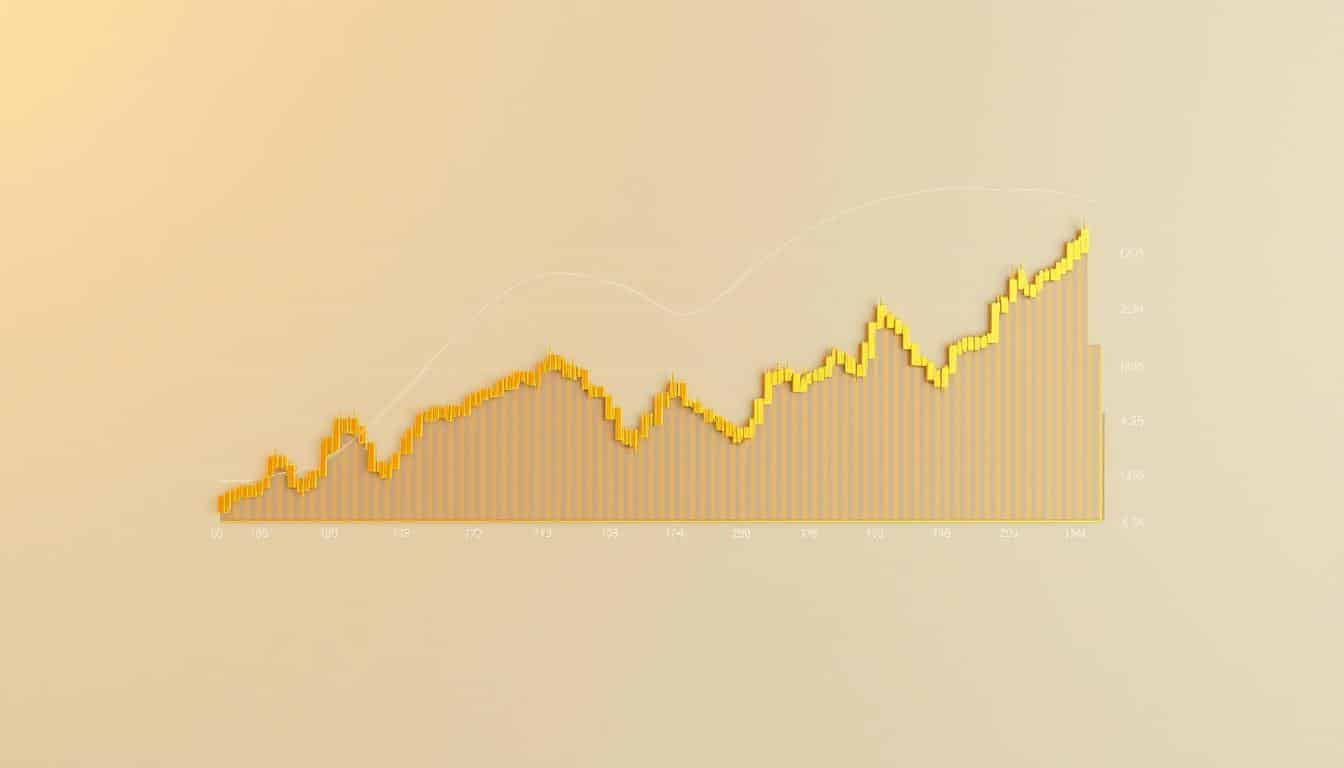Precious metal prices skyrocketed over 30% in just nine weeks. They hit a record USD 4,381.52 per ounce last October. This rally is unlike anything I’ve seen in my decade-long market watch.
At first, I thought my data feed was faulty. But the numbers were completely real.
Standard Chartered Bank predicts even more growth. They expect USD 4,300 per ounce in three months and USD 4,500 in a year. These forecasts are based on unprecedented market patterns.
This guide explains how to track gold prices effectively. I’ll share insights from years of watching current gold rates through various economic cycles.
You’ll learn about useful tools and common mistakes. We’ll also explore what these wild price swings mean for everyday investors.
Key Takeaways
- Gold reached an unprecedented USD 4,381.52 per ounce in October 2024 after a remarkable nine-week rally
- Major financial institutions predict continued upward momentum with targets exceeding USD 4,500 per ounce
- The recent 30% surge represents one of the fastest appreciation periods in precious metal market history
- Understanding price tracking tools has become essential for both new and experienced investors
- Real-time monitoring requires reliable data sources and practical chart-reading skills
- Historical patterns alone no longer provide adequate prediction frameworks for today’s volatile markets
- Personal experience combined with technical analysis offers the most balanced approach to investment decisions
Understanding Current Gold Rates
Gold rates now reflect a new way of thinking about money reserves. Today’s precious metal values respond to geopolitical shifts, policy changes, and reserve management shifts. These factors create a complex market driven by uncertainty and strategic positioning.
We’re seeing a mix of political instability, financial restructuring, and distrust of traditional currencies. This combination shapes gold prices in ways that go beyond simple supply and demand.
What Influences Gold Prices?
Recent events have changed how countries view their reserves. In 2022, asset freezes following the Ukraine conflict sparked a shift. This event became a structural catalyst for emerging market central banks.
Countries started buying gold at record rates. This behavior made sense as a hedge against potential financial isolation. Official sector purchases by central banks worldwide confirm this trend.
The Federal Reserve’s actions also impact gold prices. Rate cuts in September lowered real interest rates, boosting gold’s appeal. Lower real rates make non-yielding assets like gold more attractive.
The U.S. dollar’s weakening didn’t perfectly align with gold’s movements. Gold sometimes rises with the dollar, sometimes against it. This shows that multiple factors now influence gold prices.
Political uncertainty has also strengthened gold’s appeal. Unpredictable policies and trade tensions make investors seek out intrinsic value. Gold often benefits when government actions become hard to predict.
Historical Trends in Gold Pricing
Gold market trends repeat, but never exactly. Past crises show how gold behaves during uncertain times. The 1970s, 2008 crisis, and COVID pandemic all triggered gold surges.
These periods had different triggers but similar underlying dynamics. Gold thrives during monetary uncertainty combined with geopolitical tension. We’re experiencing similar conditions right now.
| Historical Period | Primary Catalyst | Gold Performance | Duration of Rally |
|---|---|---|---|
| 1970s Stagflation | Monetary debasement, inflation | +2,300% (1971-1980) | 9 years |
| 2008 Financial Crisis | Banking system collapse | +170% (2008-2011) | 3 years |
| COVID Pandemic | Central bank liquidity, uncertainty | +40% (2019-2020) | 18 months |
| Current Environment | Geopolitical shifts, reserve diversification | +27% (2024 YTD) | Ongoing |
Gold serves as a currency, investment, and political statement. Central banks hold it as a monetary asset. Investors use it for diversification. Countries accumulate it to show financial independence.
Historical trends reveal that gold responds more to fear and uncertainty than to economic metrics. Gold thrives when trust in institutions and currencies erodes. This happens regardless of traditional economic indicators.
Current conditions mirror those that preceded past gold rallies. Central banks diversifying from dollar reserves represent a new trend. This shift could significantly impact gold’s future performance.
Graphical Representation of Gold Prices
Charts reveal more than just numbers. They show market psychology and investor sentiment. Understanding which elements matter helps interpret gold price movements effectively.
Gold charts display price in U.S. dollars. This makes comparing historical data easier. The real value lies in understanding the patterns these charts reveal.
Interactive Gold Price Chart
Modern platforms offer interactive charts with various features. Start with a clean chart showing only price action. This helps you see pure market movement without distractions.
Spot gold prices represent the current market value. They show what buyers and sellers agree gold is worth now. This differs from futures prices, which we’ll cover later.
- Timeframe adjustments – Switch between hourly, daily, weekly, and monthly views to understand different trading horizons
- Drawing tools – Mark support and resistance levels where prices have historically bounced or reversed
- Volume indicators – Higher volume during price moves suggests stronger conviction from traders
- Moving averages – The 50-day and 200-day moving averages help identify trend direction and strength
The best charts offer logarithmic and linear scales. Logarithmic scales show percentage changes more accurately. Linear scales work better for short-term analysis of absolute price changes.
Analyzing Historical Data Trends
Gold prices surged over 30% since mid-August. They reached an all-time high of USD 4,381.52 per ounce on October 20. This steady climb suggests fundamental demand rather than speculative frenzy.
Standard Chartered analysts predict a temporary dip before prices rise again. Understanding historical context is crucial when interpreting such forecasts.
| Chart Element | What It Shows | How I Use It |
|---|---|---|
| Support Levels | Price floors where buying pressure increases | Identify potential entry points for purchases |
| Resistance Levels | Price ceilings where selling pressure increases | Recognize when rallies might pause or reverse |
| Volume Patterns | Trading activity intensity at different price levels | Confirm whether price movements have conviction |
| Moving Averages | Smoothed trend lines showing average prices | Determine overall trend direction and momentum |
When analyzing trends, I look for repeating patterns across market cycles. Gold is currently trading above its moving averages. This suggests bullish momentum but also vulnerability to profit-taking.
A correction, as predicted by Standard Chartered, would be healthy. It could bring prices back to support levels. This creates a foundation for the next upward move.
Approach historical data with both skepticism and respect. Past patterns don’t guarantee future results. However, they reveal how markets behave under similar conditions. This knowledge gives you an edge in volatile markets.
Current Gold Prices in the United States
Gold pricing isn’t as simple as one official number. Multiple price points exist for different transaction types and timeframes. Understanding these distinctions matters for investors and curious observers alike.
The gold market operates with various simultaneous price points. Each reflects different aspects of trading and delivery timelines.
Understanding Spot and Futures Pricing
The spot price is the baseline for most U.S. gold trading rates. It represents the price for delivery within two business days. This is what you’ll see on financial websites and news tickers.
Futures prices show what traders agree to pay for future gold delivery. They typically trade above spot prices due to contango.
Contango accounts for gold storage, insurance, and financing costs over time. Sometimes, futures trade below spot prices, called backwardation.
Backwardation often signals tight supply or high immediate demand. This happens during financial stress when people want physical gold now.
Most American traders use COMEX (Commodity Exchange) prices as their benchmark. COMEX hosts the world’s most liquid gold futures contracts.
Standard Chartered predicts gold reaching USD 4,300 per ounce in three months. They forecast USD 4,500 per ounce within twelve months. These are forward-looking projections based on futures and supply-demand analysis.
Some analysts expect a temporary dip first. Prices could retreat to USD 3,945-4,060 per ounce before rising again.
How Location Affects What You Pay
Regional gold price variations in the U.S. can reach $50-100 per ounce. Several factors create these differences. Understanding them helps you get better deals on physical gold.
| Factor | Impact on Price | Typical Range | Geographic Variation |
|---|---|---|---|
| Dealer Premiums | Operating costs passed to buyers | 3-8% above spot | Higher in major cities, lower in rural areas |
| State Sales Tax | Added to purchase price | 0-10% depending on state | Some states exempt precious metals entirely |
| Shipping Costs | Distance from dealer/vault | $25-75 per order | Higher for remote locations |
| Local Supply/Demand | Regional market conditions | $10-50 per ounce | Higher in economically uncertain regions |
Dealer premiums are markups above spot price. They reflect different operating costs between urban and rural locations. Rent, insurance, and wages all factor into these premiums.
State sales taxes create significant price variations. Some states exempt precious metals above certain thresholds. Others add 5-10% tax to your purchase cost.
Shipping costs matter more than expected. Online dealers charge based on insurance and distance. This can significantly increase your per-ounce cost on smaller purchases.
Local supply and demand affect prices too. Premiums tend to be higher in areas with financial instability concerns. Dealers in prepper-friendly regions often charge more due to increased local demand.
When buying gold, calculate your all-in cost. Add spot price, premium, tax, and shipping. This gives you an accurate comparison between dealers.
The current market offers interesting opportunities. Predictions show potential near-term dips before higher prices later. Timing matters for physical buyers.
Dollar-cost averaging works better than trying to time market dips perfectly. Make regular purchases regardless of short-term price movements. The long-term trend remains bullish based on gold demand factors.
Understanding these pricing mechanisms helps you make informed decisions. They directly affect what you pay and when to buy. This knowledge is crucial for both investors and casual observers.
Key Statistics on Gold Investments
Gold bullion price statistics reveal more than daily fluctuations. Demand data and production numbers show patterns that predict future prices. Understanding these stats is crucial for informed investment decisions.
Gold serves two markets: investors seeking a hedge and consumers buying jewelry. The balance between these forces shapes price trends in unexpected ways.
Standard Chartered maintains a 7% allocation to gold within its balanced investment strategy. This institutional support suggests real value beyond mere speculation.
The Battle Between Investment and Jewelry Markets
Gold investment rates have changed dramatically recently. Investment demand outpaces jewelry demand, driven by central bank purchases and currency concerns. This shift represents a fundamental change in market dynamics.
Central banks are net buyers of gold, diversifying from dollar-denominated assets. This institutional buying provides a price floor that didn’t exist before.
Interestingly, gold surged more than 30% since mid-August, yet institutional and retail ownership remains relatively low. This creates a puzzle in the market.
This data suggests two possibilities. Either there’s significant upside as more investors join, or structural factors drive the rally. My experience points to the latter.
The dollar’s 9% year-to-date weakening raises gold prices for international buyers. It also reflects concerns about U.S. fiscal and monetary policy, making gold more attractive.
India’s situation shows jewelry demand’s impact. High prices have dampened physical demand there, particularly affecting jewelry purchases. Indian consumers delay buying when gold gets expensive.
Reduced jewelry demand means more supply for investment markets. High prices encourage people to sell old jewelry, increasing available supply.
| Demand Category | Recent Trend | Primary Drivers | Price Impact |
|---|---|---|---|
| Investment Demand | Growing Rapidly | Central bank purchases, currency concerns, portfolio diversification | Upward pressure on prices |
| Jewelry Demand | Declining in Asia | High prices, economic uncertainty, changing consumer preferences | Reduces consumption, increases recycled supply |
| Technology Demand | Stable Growth | Electronics manufacturing, medical applications, industrial uses | Steady baseline support |
| Seasonal Buying | Cyclical Patterns | Lunar New Year, Indian festivals, wedding seasons | Temporary price support during peak periods |
Seasonal patterns add another layer to gold investment rates. Lunar New Year drives increased buying in Asia for jewelry and gifts. This seasonal demand can temporarily support prices even when broader fundamentals soften.
Chinese and Indian festival calendars create predictable demand spikes. These offer short-term trading opportunities and context for price movements.
Production Constraints That Support Prices
Gold mining production is crucial to the supply side. Mining requires significant capital and time. You can’t quickly increase gold production when prices rise.
Global gold mining production has been relatively flat for the past decade. This supply constraint helps gold maintain value over time.
New mines take years to develop. Even with high prices, supply response is slow. Existing mines deplete, and finding new deposits becomes harder.
Supply inflexibility greatly impacts long-term price dynamics. When investment demand increases, supply can’t quickly adjust. This imbalance drives prices higher until demand moderates.
Environmental regulations and mining costs have increased substantially. Some deposits are no longer profitable to extract at current costs. This effectively reduces the accessible gold supply.
These statistics paint a clear picture. The gold market is supported by structural factors, not speculative enthusiasm. This suggests a more sustainable trend than a momentum-driven rally.
Predictions for Future Gold Prices
Forecasting precious metal values is complex, but some predictions are more reliable. I approach gold forecasts cautiously, having seen many fail. Financial institutions’ systematic projections deserve attention.
Standard Chartered predicts gold to reach USD 4,300 per ounce within three months. They expect USD 4,500 per ounce within twelve months. This represents a 7-10% increase, significant but realistic.
They acknowledge prices could dip to USD 3,945-4,060 per ounce before rising again. This honest forecasting aligns with my observations of gold market trends.
Expert Analysis and Forecasts
Rajat Bhattacharya, Senior Analyst at Standard Chartered, maintains a “structurally bullish stance” on gold. His approach emphasizes structural factors over cyclical ones. This distinction is crucial for investors.
Cyclical factors create temporary price movements that eventually reverse. Structural factors represent fundamental shifts in market operations. These create sustained trends lasting years or decades.
Bhattacharya’s analysis suggests we’re in a multi-year bull market. The projected pullback to USD 3,945-4,060 would allow market consolidation. Standard Chartered sees dips below USD 4,000 per ounce as buying opportunities.
Economic Indicators Affecting Gold Prices
Five key metrics correlate strongly with precious metal values. These include real interest rates, dollar index, central bank policies, geopolitical risks, and inflation expectations.
- Real interest rates: Nominal rates minus actual inflation—when these are low or negative, gold becomes more attractive
- Dollar index (DXY): Gold typically moves inversely to dollar strength
- Central bank policy statements: Both official rates and commentary about fiscal concerns
- Geopolitical risk indices: Measured through various international tension metrics
- Inflation expectations: Forward-looking measures of where inflation is headed
Most indicators currently support gold. Real rates remain low, and the dollar is weakening. Central banks signal fiscal concerns, while geopolitical tensions stay high.
Inflation expectations exceed the Fed’s 2% target, historically supporting higher gold prices. This creates a “supportive backdrop” for precious metal values.
Two near-term risks deserve attention. A hawkish Fed shift could strengthen the dollar, temporarily lowering gold prices. Slowing Indian demand due to high prices is another concern.
| Factor Type | Current Impact | Timeframe | Confidence Level |
|---|---|---|---|
| Structural (Central bank buying) | Strongly bullish | Multi-year | High |
| Structural (Currency distrust) | Bullish | Multi-year | High |
| Cyclical (Indian demand) | Temporarily bearish | Months | Medium |
| Cyclical (Fed policy risk) | Neutral to bearish | Quarters | Medium |
Standard Chartered emphasizes distrust as a fundamental driver. They state, “Gold’s strength is not just uncertainty—it’s distrust.” This distrust operates on multiple levels.
People distrust traditional reserve currencies and central bank policies. There’s also skepticism about the international monetary system’s stability. This issue took years to develop and will likely take years to resolve.
My view: We’re in a multi-year gold bull market. The USD 4,500 twelve-month target seems reasonable, possibly conservative. Expect significant volatility with 5-10% corrections.
The key is distinguishing between healthy corrections and trend reversals. Major changes would need to occur before reconsidering the bullish thesis. These include improved fiscal discipline and resolved geopolitical conflicts.
Until then, view dips as opportunities rather than warnings. The structural factors supporting gold remain strong.
Tools for Monitoring Gold Prices
Tracking gold prices requires the right tools. I’ve tested many platforms over the years. Here are the ones I use daily and why they’re valuable.
A simple setup is all you need. Reliable pricing and quick change detection are crucial. Mobile apps for quick checks and desktop sites for deep analysis cover most needs.
Mobile Apps for Tracking Gold Prices
The Kitco app is my top pick for mobile gold tracking. It’s free, updates in real-time, and shows prices for various precious metals. Its clean interface makes finding information easy.
Kitco’s price alert feature is a standout. You can set notifications for specific thresholds. This means less constant phone checking. I use alerts for key support and resistance levels.
GoldPrice.org’s app shines with its multi-currency function. It’s great for international markets or travel planning. The app includes basic historical charts too.
TradingView’s app offers detailed technical analysis on mobile. It’s not gold-specific but allows charting of spot gold and futures. It’s surprisingly capable for on-the-go chart pattern checks.
Here’s my practical mobile setup:
- Kitco for quick live gold rates checks and price alerts
- GoldPrice.org for international currency comparisons
- TradingView for technical chart analysis when needed
These three apps cover different aspects without overlap. Each serves a specific purpose in my monitoring routine.
Websites to Check Real-Time Rates
For desktop monitoring, I use different bookmarks. Kitco.com is my go-to for fast spot price checks. It shows current prices for all major precious metals.
Kitco’s market commentary quality sets it apart. Unlike gold dealer sites, Kitco provides balanced analysis. You get real market perspective, not just sales pitches.
BullionVault.com offers unique actual market pricing. You see real buy and sell orders, not theoretical spot prices. This reveals realistic transaction costs.
Goldprice.org’s website provides comprehensive currency coverage. You can view gold prices in almost any currency. This helps understand gold’s performance across different monetary environments.
TradingView.com is essential for professional-level monitoring. It offers custom watchlists, multiple indicators, and asset comparisons. The premium subscription is worth it for serious analysis.
My saved template shows gold futures, dollar index, S&P 500, and Treasury yields. This gives a complete macro snapshot affecting gold at a glance.
The COMEX website provides official futures prices and volume data. It’s technical but invaluable for understanding professional traders’ actions.
The World Gold Council’s website offers crucial context. Their quarterly reports explain supply and demand factors behind price movements.
My desktop monitoring setup includes:
- Kitco.com for quick live gold rates verification
- TradingView for detailed technical analysis and correlations
- BullionVault for realistic transaction pricing
- World Gold Council reports quarterly for fundamental context
This combination covers price action, technical patterns, and fundamentals without information overload. For critical decisions, I use COMEX futures data.
Find tools that match your specific monitoring needs. Start simple with one mobile app and one website. Expand only if you find information gaps.
Frequently Asked Questions About Gold Investing
Gold investing sparks questions that need clear, experience-based answers. These questions mirror concerns I had when I first explored precious metals. Let’s explore the most common ones in a practical order.
The learning curve isn’t as steep as you might think. However, specific details matter. These details can save you money and help you avoid common mistakes.
How Do I Buy Gold?
There are several ways to purchase gold, each with its own pros and cons. Your choice depends on your investment amount, physical possession preference, and comfort with different investment types.
Physical gold can be bought from dealers like APMEX, JM Bullion, or local coin shops. You own something real that you can hold. However, storage, insurance, and premiums above spot price are concerns.
Dealers typically charge 3-8% above spot for coins, less for larger bars. I focus on widely recognized products like American Gold Eagles or Canadian Gold Maples. Avoid “collectible” or “limited edition” items unless you’re interested in numismatics.
Gold ETFs like GLD or IAU offer exposure to gold prices without physical possession. You buy shares through your brokerage account just like stocks. These funds hold physical gold in vaults.
The share price tracks gold bullion prices minus a small management fee, typically around 0.4% annually. This method is liquid, secure, and has lower transaction costs than physical gold.
Gold mining stocks and mining ETFs like GDX provide leveraged exposure to gold prices. When gold goes up, mining stocks typically go up more—and vice versa. They offer potentially higher returns but with higher risk.
Gold futures and options are for experienced traders. Unless you thoroughly understand leverage and risk management, skip these entirely. Even with significant experience, they’re challenging to trade profitably.
| Purchase Method | Best For | Typical Costs | Liquidity |
|---|---|---|---|
| Physical Gold (Coins/Bars) | Investors wanting tangible assets | 3-8% premium over spot price | Moderate (requires finding buyer) |
| Gold ETFs (GLD, IAU) | Most retail investors | 0.4% annual management fee | High (instant trading) |
| Mining Stocks/ETFs | Higher risk tolerance investors | Standard brokerage commissions | High (instant trading) |
| Futures/Options | Experienced traders only | Margin requirements plus commissions | Very high (but complex) |
Is Gold a Safe Investment During Inflation?
The evidence is more nuanced than most people realize. Gold has historically performed well during high inflation periods. The 1970s are a classic example of this trend.
The logic is simple: inflation erodes currency value, so people move into real assets like gold. However, the relationship isn’t perfect. In the 1980s and 1990s, we had moderate inflation but falling gold prices.
Why? Because real interest rates were positive and rising. When you can get 5-6% real return from Treasury bonds, gold loses appeal. This kept gold prices depressed for decades.
The current environment is interesting because we have inflation concerns combined with low real interest rates. That’s historically when gold performs best. Current gold investment rates reflect this dynamic.
Standard Chartered maintains a 7% allocation to gold within their balanced investment strategy. For investors with limited exposure, they recommend “averaging in” during periods of weakness rather than committing everything at once.
Dips below USD 4,000 per ounce would likely represent buying opportunities for long-term investors. That’s roughly where I keep my own allocation, though I adjust based on market conditions.
The averaging-in strategy makes sense. It means buying gradually rather than timing the market perfectly. If gold dips to the USD 3,945-4,060 range, that would be an averaging-in opportunity.
The key is having a plan before the dip happens. In the moment, falling prices create anxiety that prevents action. Write down your buy levels now, while you’re thinking clearly.
Other common questions worth addressing:
- What percentage of my portfolio should be in gold? I typically recommend 5-10% for most investors, adjusted based on risk tolerance and market conditions.
- Should I buy gold coins or bars? Coins for smaller amounts (more liquidity, wider market), bars for larger amounts (lower premiums per ounce).
- Where do I store physical gold? A home safe for smaller amounts, a bank safe deposit box or private vault service for larger amounts.
- Do I need to report gold purchases? In the U.S., dealers must report certain transactions above specific thresholds, but generally, buying gold is private.
- What about digital gold or blockchain-based gold? Interesting developments, but I’m cautious. The whole point of gold is that it’s a physical asset outside the financial system.
Understanding these fundamentals helps you make informed decisions about whether gold fits your investment strategy. The relationship between gold investment rates and inflation isn’t automatic. Over long periods, gold has preserved purchasing power better than most alternatives.
Your specific situation matters more than any general rule. Consider your time horizon, risk tolerance, and gold’s role in your portfolio. For me, it’s insurance against monetary instability—a long-term store of value.
Sources for Gold Pricing Information
Not all gold price sources are trustworthy. Quality information is crucial for tracking live gold rates and making investment decisions. Knowing where gold pricing data comes from helps you avoid costly mistakes.
The reliability of sources varies greatly. Some websites provide real-time market data from established exchanges. Others may publish delayed information or manipulate numbers for sales.
Government and Financial Institutions
Government agencies and financial institutions offer authoritative gold market data. They report facts without trying to sell anything. The U.S. Geological Survey publishes annual reports on gold mining, forming the basis for supply-side analysis.
The World Gold Council produces essential quarterly reports on global gold supply and demand. Their transparent methodology is referenced by central banks and institutional investors worldwide.
Central banks publish research on gold’s role in reserve management. These reports offer insights into how official institutions view gold. Central banks collectively hold about one-fifth of all mined gold.
Major financial institutions publish market-moving research. Standard Chartered Bank recently forecast gold to reach USD 4,300 within three months. This analysis by Rajat Bhattacharya, Senior Analyst, reflects significant analytical resources.
Goldman Sachs, JP Morgan, and other big banks also publish gold market research. Their projections are backed by proprietary data and global market access.
The CME Group operates the COMEX futures market, the primary benchmark for North American gold trading. Their data feeds power most live gold rates on financial websites.
The London Bullion Market Association sets another crucial benchmark. The LBMA gold fix happens twice daily and serves as the global reference price.
Online Marketplaces and Exchanges
Online platforms show actual transaction prices, not just theoretical benchmarks. BullionVault operates a real marketplace where you can see live buy and sell orders.
Major online dealers like APMEX, JM Bullion, and SD Bullion publish their premiums over spot prices daily. These premiums can indicate physical supply changes before they affect COMEX trading.
Kitco and Bloomberg are reliable sources for live gold rates. Kitco aggregates data from multiple sources and clearly labels price types.
Bloomberg has institutional-grade infrastructure and direct connections to global trading desks. Their prices reflect actual market conditions, even with a 15-minute delay for free users.
Avoid websites promising “secret” gold price predictions or using fear tactics. Be wary of heavily advertised dealers making apocalyptic claims. Check their prices against reputable dealers before buying.
Stay skeptical of “sponsored content” disguised as objective analysis. Look for bylines, check author credentials, and verify claims against multiple sources.
Cross-referencing multiple sources is the most reliable approach. Compare forecasts from major institutions like Standard Chartered, Goldman Sachs, and Bank of America.
Use COMEX as your primary reference during U.S. trading hours and LBMA during the London session. Understanding active trading centers helps interpret price movements and assess liquidity conditions accurately.
Conclusion: Staying Informed on Gold Prices
Tracking gold rates doesn’t mean watching screens constantly. Understanding the broader context is more important than hourly changes. A USD 100 move is normal when gold trades above USD 4,000 per ounce.
Why Regular Price Monitoring Matters
Daily price checks help maintain awareness of structural trends. Standard Chartered projects gold to reach USD 4,300 in three months and USD 4,500 in twelve months.
Dips below USD 4,000 per ounce might be buying opportunities for patient investors. Regular monitoring helps distinguish normal volatility from significant market shifts.
A 2-3% daily move during volatile periods is typical for precious metals. It shouldn’t cause panic or excessive excitement.
Practical Advice for Smart Investing
Keep your gold allocation to 5-10% of your portfolio as insurance. Average into positions gradually to avoid mistiming entries.
Use reliable sources like institutional research and government statistics for pricing data. Ignore noise from extreme gold bulls and skeptics.
Focus on fundamental factors driving prices: real interest rates, currency trends, and central bank policies. These matter more than short-term signals or social media chatter.







